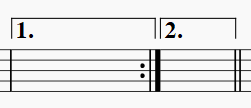Back • Return Home
The Basics of Rhythm (Part 3)
Changing In Speed
We can speed up or slow down within a piece of music using certain Italian words. These override the Tempo until they are are cancelled out by an "A Tempo". For example:
Ritardano (usually abbreviated as "Rit.") and Rallentando (usually abbreviated as "Rall.") mean to gradually slow down. The opposite is Accelerando (usually abbreviated as "Accel."), which means to gradually speed up.
These words can be modified by two other Italian words: "Poco" (meaning "a little") and "Molto" (meaning "a lot").
So, if you see "Poco Rit." underneath some Notes in a piece of sheet music, it means to slow down a bit as you sing or play them. How slow is determined by the context.
Looping & Ending
Repetitions may not necessarily be notated. For example, sometimes we may need to continuously repeat some bit of music as a background for something else that is not of any set duration (like someone talking). This is generally referred to as an Ostinato (or Vamp).
If it has to be notated, then rather than writing sections out over and over again, we can use various symbols to show what should be repeated and how.
First, there is a Repeat Measure symbol: 
If this shows up right in the middle of a Measure, then it is telling us to repeat whatever is within the Measure that comes before it.
If we want to repeat several Measures, then we can use a Double Barline:

Whenever we reach a Double Barline like the one on the right (with its two dots pointed to the left), then we jump back to the Double Barline like the one on the left (with the two dots pointed to the right) and play through everything between them again. Double Barlines usually form pairs like this.
They may also be used in combination with several other symbols...
The Segno (or "sign"): 
One may come across the Italian phrase, "D.S. al Fine". The acronym D.S. means "Dal Segno" (literally "from the sign"). So, the phrase D.S. al Fine means to start again from the  , and play all the way through to the section marked "Fine" (or "end"). To reiterate, D.S. al Fine means "from the sign to the end".
, and play all the way through to the section marked "Fine" (or "end"). To reiterate, D.S. al Fine means "from the sign to the end".
A similar phrase is "D.S. al Coda". Again, the D.S. acronym means "Dal Segno" (or "from the sign"). The term "Coda" (literally "tail") is another way of saying "ending". It is usually marked by a specific symbol: 
Therefore, D.S. al Coda means to start again from the  , and play all the way through to the section marked "al Coda" (or "to the tail"). Then, jump straight from there to the section marked with the
, and play all the way through to the section marked "al Coda" (or "to the tail"). Then, jump straight from there to the section marked with the  , and play it to the end.
, and play it to the end.
[Hopefully, the above explanation is clear. For a more thorough explanation of the use of D.S. al Coda, check out the article by Music Reading Savant.]
There are also First and Second Endings:

Whenever we reach the Double Barline by playing through the "First Ending" marked 1, then we jump back to the Double Barline that it is paired with. Once we play through it all again, we skip over all of the Measures contained by 1 and play the "Second Ending" marked 2.
Finally, at the very end of a piece of music, we may encounter a Fermata: 
This means to hold the marked Notes, letting them ring out indefinitely. These sounds will naturally decay or "Fade Out".



 , and play all the way through to the section marked "Fine" (or "end"). To reiterate, D.S. al Fine means "from the sign to the end".
, and play all the way through to the section marked "Fine" (or "end"). To reiterate, D.S. al Fine means "from the sign to the end".

 , and play all the way through to the section marked "al Coda" (or "to the tail"). Then, jump straight from there to the section marked with the
, and play all the way through to the section marked "al Coda" (or "to the tail"). Then, jump straight from there to the section marked with the  , and play it to the end.
, and play it to the end.

